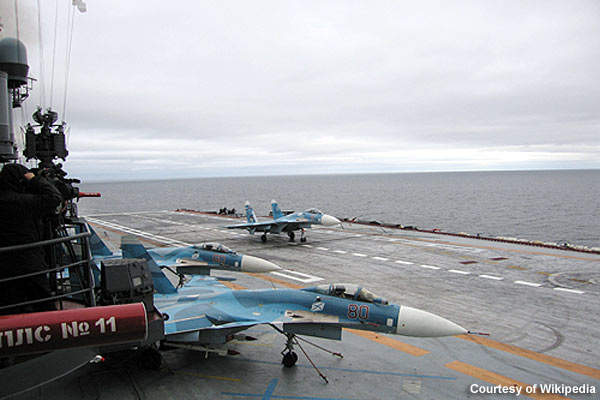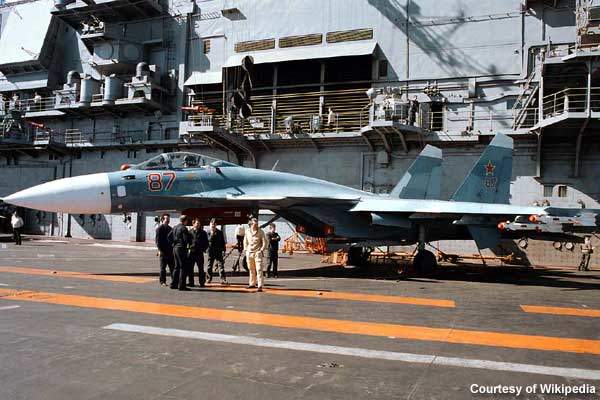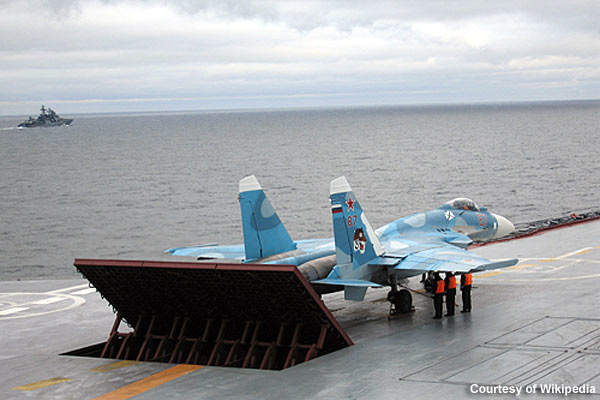The Su-33 is a single-seat multirole carrier-based conventional take-off and landing (CTOL) fighter aircraft. It is manufactured by Sukhoi in Komsomolsk-on-Amur, Russia. The aircraft has been principally designed and developed to meet the requirements of the Russian Navy.
The aircraft is derived from its predecessor, the Su-27, and its Nato reporting name is Flanker-D. It performed its maiden flight in May 1985 and entered into service in 1994. The aircraft can be operated any time under the aid of the command centre ship.
The Su-33 can destroy hostile aerial targets, provide fire support and demolish ground and sea targets using missiles and rocket bombs. It also renders escort, reconnaissance and laying of minefields missions.
Su-33 aircraft design
The aircraft was designed by Russia’s Sukhoi Design Bureau. The design phase began in 1984 and was finalised in 1985.
The aircraft is equipped with sports canards to reduce the take-off distance and enhance manoeuvrability, and has power-aided folding wings.
The aircraft is also fitted with an air-refuelling probe to increase its range. The wings are fitted with a two-piece, single-slotted flap, an aileron and a larger leading-edge flap to decrease speed when landing.
Su-33 features
The Su-33’s airborne warning and control system is used to automatically detect, track, recognise and spot up to ten aerial and ground-based targets. The aircraft is equipped with a long-range navigation system which determines the fighter’s location based on the signals supplied by the ground station.
Aircraft armaments
The aircraft is armed with 30mm Gsh-30-1 cannons. It features 12 external hardpoints on which are mounted R-27R1(ER1), R-27T1(ET1) and R-73E air-to-air missiles, S-8KOM, S-8OM, S-8BM S-13T, S-13OF and S-25-OFM-PU unguided missiles, Kh-25MP, Kh-31 and Kh-41 guided missiles, RBK-500 cluster bombs and electronic counter measure pods.
Su-33 aircraft avionics
The Su-33’s avionics include a fire control system, flight navigation system, doppler navigation radar, global positioning system, attitude and heading reference system, marker radio receiver, remote control system and IFF (identification friend or foe) transponder, radar warning receiver and radio jamming transmitter.
ECM, communication systems, on-board monitoring system, emergency warning system, aircraft responder and on-board voice information playback equipment are also installed in Su-33.
AL-31F turbofan engines
The aircraft is powered by two AL-31F afterburning turbofan engines. Each engine can produce 15,500 kilogram-force (kgf) of thrust.
The AL-31F is a high-temperature engine and can operate under extreme conditions of air inlet distortion and fluctuation.
The engine, manufactured by NPO Saturn, is 4.95m long with a diameter of 0.91m and weighs around 1,520kg.
Landing gear
The landing gear is reinforced with a double-wheel nose unit, an arrestor hook and naval navigational aids.
Su-33 aircraft performance
The aircraft can climb at the rate of 325m/s. It has a maximum speed of 2,300km/h and a stall speed of 240km/h. Its maximum range is 3,000km, while the service ceiling is 17,000m. The aircraft weighs around 18,400kg and its maximum take-off weight is 33,000kg.








